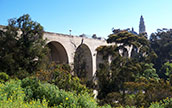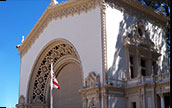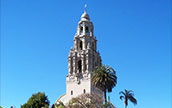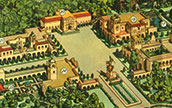

PROJECTS
Prado/Plaza de Panama Historic Resources
Technical Report
LOCATION: San Diego, California
CLIENT: Recon Environmental
DATE COMPLETED: April 2012
San Diego's Balboa Park is one of the top urban parks in the world. Set aside in 1868, the 1,400-acre park played host to the Panama-California Exposition in 1915 and to the California Pacific International Exposition in 1935. The centerpiece of both expositions was the El Prado/Plaza de Panama complex, designed by architect Bertram Goodhue with later contributions by San Diego's own Richard S. Requa. Presently San Diego's primary museum and cultural district, as well as a major tourist destination, this precinct represents one of the finest groupings of ornate Spanish Colonial Revival buildings and formally designed Spanish, Mexican, and Moorish gardens and plazas anywhere in the world. The buildings and gardens are linked together by a landscaped drive called El Prado, which opens out into a large hardscaped plaza called Plaza de Panama.
Sponsored by local philanthropist and Qualcomm founder, Dr. Irving Jacobs, the proposed project calls for the removal of automobiles from the El Prado/Plaza de Panama complex and the restoration of pedestrian uses throughout the Balboa Park Historic District.
Working as a member of a team lead by Recon Environmental, Chris VerPlanck prepared a Historic Resources Technical Report that analyzes the development of Balboa Park and its National Historic Landmark-listed El Prado/Plaza de Panama complex. The report assesses the significance of the buildings and landscapes within the area of potential effect and analyzes the potential impacts of the proposed project, which in addition to landscaping El Prado and Plaza de Panama in a more compatible vocabulary, calls for the construction of a new bridge and secondary means of circulation to bypass the precinct and to access a new parking structure outside the historic district core.



